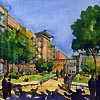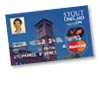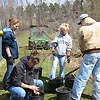Goal 6:
Provide safe, accessible, effective,
efficient and inviting physical facilities
Campus identity enhanced
A new exterior signage project was completed for the campus. The comprehensive signing enhances the university's identity, replacing 20-year-old redwood signs.
New housing plans under way
 An
aggressive schedule was established to replace the aging Jeter, Tainter
and Callahan residence halls on North campus, with new housing for junior-
and senior-level students. The campus worked closely with architects to
design a modern suite-type residence hall that can accommodate approximately
300 students. Construction is scheduled to begin in January 2004.
An
aggressive schedule was established to replace the aging Jeter, Tainter
and Callahan residence halls on North campus, with new housing for junior-
and senior-level students. The campus worked closely with architects to
design a modern suite-type residence hall that can accommodate approximately
300 students. Construction is scheduled to begin in January 2004.
Employee health opportunities offered
The Optimal Health Committee supports healthy lifestyles by providing UW-Stout employees with opportunities to increase their health awareness. Approximately 300 staff and students attended the committee's annual Optimal Health Fair to view health-related exhibits; eat chocolate; try out fitness equipment; and receive massages, hearing tests and blood pressure tests.
Other initiatives sponsored by the committee included:
- CPR training.
- skin cancer, fibromyalgia and smoking cessation presentations.
- cross-country skiing workshop.
- health-related communications with employees through weekly e-mail articles, a newsletter and a new Web site developed by students in the applied psychology master's degree program.
New campus card
provides electronic services
 To
complement its digital environment, UW-Stout partnered with Higher One,
a financial services firm, to implement a new campus card system that
makes business transactions more convenient and expands online services.
To
complement its digital environment, UW-Stout partnered with Higher One,
a financial services firm, to implement a new campus card system that
makes business transactions more convenient and expands online services.
The system allows students and employees to complete transactions anywhere, anytime. Cardholders can choose to use their OneCard as a primary bank account, allowing them to get cash from ATMs, write checks, send and receive money electronically from their accounts, and monitor the details of their accounts on an interactive Web site.
The service also makes it possible for students to receive financial aid refunds electronically to their card account, eliminating the production of 11,000 checks annually. Student employees may also receive their payroll checks electronically. These digital solutions resulted in increased efficiency and cost savings for the university.
Grounds chemical use reduced
In celebration of Earth Day, the UW-Stout grounds department began a four-year test project using corn gluten meal as an organic weed reducer. An application of a granulated form of corn gluten was applied to several areas on campus as an organic method of controlling weeds in lawns, shrubs and garden areas.
To reduce the use of chemicals on campus, the following practices were also initiated:
- Testing new grass varieties that withstand heavy traffic, dry soil and weed infestation
- Increasing use of mulches, such as shredded bark, to reduce weed germination
- Improving landscape designs to reduce the need for herbicide spraying
- Using granulated turkey manure in place of synthetic fertilizers.
Collaboration to restore campus wetland
 The
UW-Stout grounds department and four students in a biology course undertook
a project to rid the small, diverse wetland on the south side of campus
of the invasive purple loosestrife plant. In conjunction with the Wisconsin
Department of Natural Resources, the group raised several thousand Galerucella
beetles, natural enemies of purple loosestrife.
The
UW-Stout grounds department and four students in a biology course undertook
a project to rid the small, diverse wetland on the south side of campus
of the invasive purple loosestrife plant. In conjunction with the Wisconsin
Department of Natural Resources, the group raised several thousand Galerucella
beetles, natural enemies of purple loosestrife.
The students dug loosestrife roots from the wetland, potted them and raised the plants in a makeshift wetland. After receiving 100 beetles from the DNR, the group placed the bugs on the plants, covered them with netting and left them to multiply to one hundred times their original population.
Some of the Galerucella beetles the group raised were set loose in the university's loosestrife infested wetland. The rest were given to the DNR to be used in other state wetlands.
Additional Resources:
- Optimal Health
http://www.uwstout.edu/health/ - Campus Card
Student Life Services
http://www.uwstout.edu/stoutonecard/ - Purple Loosestrife Factsheet
Department of Natural Resources
http://www.dnr.state.wi.us/org/land/er/invasive/factsheets/loose.htm
